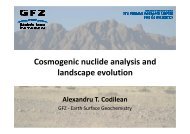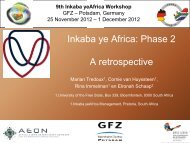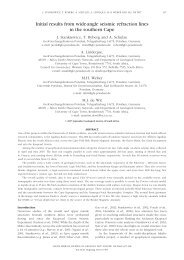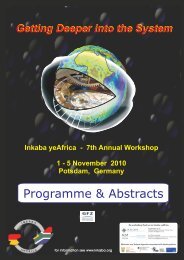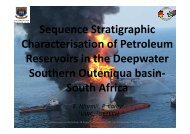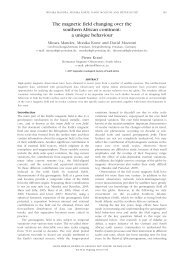South Africa - Inkaba.org
South Africa - Inkaba.org
South Africa - Inkaba.org
You also want an ePaper? Increase the reach of your titles
YUMPU automatically turns print PDFs into web optimized ePapers that Google loves.
An Investigation of the Trace Element Compositions of Gold<br />
from the Zimbabwe and <strong>South</strong> <strong>Africa</strong> : Implications for tracing<br />
the source of archeological gold<br />
Robert Netshitungulwana 1 , M. Tredoux 2 , L. Jacobson 3<br />
1. Council for Geoscience, <strong>South</strong> <strong>Africa</strong>, robertn@geoscience.<strong>org</strong>.za<br />
2. University of Free State, <strong>South</strong> <strong>Africa</strong>, mtredoux@ufs.ac.za<br />
3. McGregor Museum, <strong>South</strong> <strong>Africa</strong>, jake@museumsnc.co.za<br />
ABSTRACT<br />
The early Bantu farmers who settled in southern <strong>Africa</strong> were involved in trading and metal technology, and the<br />
history of mining for metals like iron, copper, tin and gold in southern <strong>Africa</strong> spans at least the past 2000 years.<br />
The main aim of the research was to test the viability of using gold chemistry to compare the composition of gold<br />
ores in <strong>South</strong> <strong>Africa</strong> and Zimbabwe with those of the archaeological gold artefacts in Thulamela, Mapungubwe,<br />
Bosutswe and Great Zimbabwe. Samples from Archaean greenstone belt in <strong>South</strong> <strong>Africa</strong> and Zimbabwe, as well as<br />
samples from ores associated with the Witwatersrand Supergroup, were used in the study.<br />
Trace element signatures were determined by laser ablation inductively coupled plasma mass spectrometry (LA-<br />
ICP-MS), a technique whereby low concentration (down to low ppb levels) can be detected. In addition, Ag<br />
concentrations (wt. %) were determined using scanning electron microprobe, so that Ag could be used as an<br />
internal standard during the LA-ICP-MS runs to give semi-quantitative data. The most commonly occurring<br />
isotopes in gold, namely, 56 Fe, 59 Co, 60 Ni 63 Cu, 66 Zn, 75 As, 188 Os, 105 Pd, 195 Pt, 202 Hg, 107,109 Ag, and 204, 206,207,208 Pb<br />
and 209 Bi, were used to construct the signatures, using their intensities in the mass spectra in counts per second<br />
(cps). Isotopic ratios were used to compare the gold ores with the gold artefacts.<br />
The results show some variations in the signatures of gold from the greenstone belts and the Witwatersrand Basin.<br />
The 107 Ag and 202 Hg cps in gold from the Witwatersrand Basin are high compared to the greenstone belts. These<br />
differences have implications for the various models of gold deposition in these environments, pointing to different<br />
geochemical histories. Multivariate correspondence analysis plots for the major gold deposits show the wide group<br />
of the Barberton samples with little or no distinctive characteristics compared to the Zimbabwean gold samples.<br />
The Witwatersrand gold plot differently to the Barberton greenstone belt but closely related to the Zimbabwean<br />
greenstone belts. The ratio plot of 56 Fe (10 5 )/ 107 Ag versus 202 Hg (10 5 )/ 107 Ag shows that archaelogical gold artefacts<br />
differ completely from the natural gold, indicating that the gold could not merely have been gold-worked, as has<br />
been suggested. This suggests that gold from any one archaeological site could not be related to any particular or<br />
even regional source. The problem could be associated with the possibility of mixing of gold from multiple<br />
sources, recycling, contamination in melting, and trade in items.<br />
KEYWORDS: Archaeology, Gold, Trace element analysis, <strong>South</strong>ern <strong>Africa</strong>, Zimbabwe<br />
Netshitungulwana Robert. 1 received his Bachelor of Science (Honours) (BSc.H) degree<br />
in Geology from the University of Venda, <strong>South</strong> <strong>Africa</strong> in 2003. He is currently doing his MSc.<br />
Degree at the University of Free State, <strong>South</strong> <strong>Africa</strong>, with research interest geared towards<br />
“trace elements geochemistry in southern <strong>Africa</strong>n gold and artefacts”. He has done<br />
geochemical fieldwork, compiling geochemical maps and data interpretation in <strong>South</strong> <strong>Africa</strong><br />
and internationally with Council for Geoscience, <strong>South</strong> <strong>Africa</strong>.<br />
. 1 Department of Geology, University of Free State -Bloemfontein , SA<br />
Email: robertn@geoscience.<strong>org</strong>.za / Mobile +27 73 339 9917<br />
60



